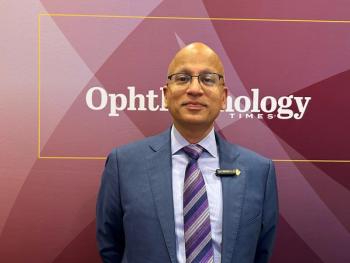
Presbyopia-correcting IOLs evaluated in study
Results of a prospective, randomized, patient-masked clinical trial evaluating three presbyopia-correcting IOLs show predictable refractive outcomes were achieved with all three technologies, but indicate there are some differences between the IOLs in visual performance, said Robert E.T. Ang, MD, Asian Eye Institute, Makati City, Philippines.
Makati City, Philippines-Results of a prospective, randomized, patient-masked clinical trial evaluating three presbyopia-correcting IOLs show predictable refractive outcomes were achieved with all three technologies, but indicate there are some differences between the IOLs in visual performance, said Robert E.T. Ang, MD, Asian Eye Institute, Makati City, Philippines.
Dr. Ang presented data from the study that enrolled 78 patients undergoing bilateral cataract surgery. Eligible patients were aged 40 years and older and had best-corrected visual acuity (BCVA) or potential acuity of 20/30 or better with less than 1.25 D of astigmatism.
Patients were randomly assigned to implantation of the +3-D add version of the apodized diffractive multifocal IOL (n = 27; AcrySof ReSTOR +3, Alcon Laboratories), the full-diffractive multifocal IOL (n = 25; Tecnis Multifocal, Abbott Medical Optics), or the aberration-free accommodating IOL (n = 26; Crystalens AO, Bausch + Lomb). Follow-up to 6 months is planned, and results were available from a 30- to 60-day visit. Outcomes included contrast sensitivity, refraction, and high- and low-contrast visual acuity at near, intermediate, and distance.
The interim results showed patients who received the accommodating IOL had significantly better mesopic contrast sensitivity with and without glare versus both of the comparators, and this difference translated into superior uncorrected vision at far and intermediate distances in a low-contrast situation.
“Each of these lenses has its own strengths and weaknesses,” Dr. Ang said. “Matching these features to the individual’s needs and expectations is the key to clinical success.”
All patients in the study were Asian, and the three IOL groups were similar with respect to mean patient age (~65 years) and gender distribution (~80% female). All preoperative measurements were performed with partial coherence inferometry (IOLMaster V5, Carl Zeiss Meditec) and power calculations were performed with the SRK-T. Visual acuity and contrast sensitivity were measured using the same instrument (Optec 6500 Vision Tester, StereoOptical), which allowed for standardization of lighting. The test distance was 16 inches for near vision and 26 inches for intermediate.
In binocular mesopic contrast sensitivity testing with and without glare, the results were significantly better for patients with the accommodating IOL compared with each of the multifocal IOL groups due to better performance at low and midspatial frequencies (1.5, 3, and 6 cpd). There were no significant differences between the two multifocal IOL groups in testing with or without glare at any spatial frequency.
The mean refractive outcomes were near emmetropia in all groups, but the mean sphere was slightly myopic in eyes with the accommodating IOL implanted (–0.07 ± 0.52 D) and slightly hyperopic in eyes with the full diffractive (0.25 ± 0.35 D) and apodized diffractive (0.15 ± 0.50 D) multifocal IOLs. Mean cylinder was about –0.60 in all three groups and mean MRSE ranged from –0.36 D for the accommodating IOL eyes to –0.02 D in the full diffractive multifocal IOL group.
“It is very important to develop a nomogram to achieve the desired refractive outcome for each of the IOLs,” Dr. Ang said. “Visual performance seems to be best if the accommodating IOLs are targeted for mild myopia, whereas the multifocal IOLs work best when targeted to slight hyperopia.
“Our data show that refractive outcomes can be consistently targeted with all three lenses,” he added. “However, visual performance is also influenced by contrast sensitivity.”
In high-contrast testing, mean distance logMAR uncorrected visual acuity (UCVA) was numerically better for the accommodating IOL group and diffractive multifocal IOL groups compared with the apodized diffractive IOL group (Snellen equivalent 20/20 versus 20/25). However, there were no statistically significant differences between groups in mean distance logMAR UCVA.
Under low contrast, distance logMAR UCVA was significantly better in eyes with the accommodating IOL and the diffractive multifocal IOL (Snellen equivalent 20/32 for both) implanted than for eyes with the apodized diffractive multifocal IOL (20/40).
In near vision testing, there were also no statistically significant differences between groups under high-contrast conditions (Snellen equivalent 20/25 in all groups), whereas in low-contrast testing, the results suggested a slight edge for the accommodating IOL (Snellen equivalent 20/40 versus 20/50 in the other two groups). However, the benefit compared with the other groups was not statistically significant.
“The mildly myopic result of the accommodating IOL lessened its superiority for providing better distance vision under low contrast but helped to negate the superiority of the multifocal IOLs for providing better near vision,” Dr. Ang said.
For intermediate vision, the accommodating IOL outperformed the two multifocal IOLs in both low- and high-contrast testing, and the differences between groups in mean logMAR UCVA were statistically significant. Mean Snellen equivalent intermediate UCVA for eyes with the accommodating IOL was 20/20 under high contrast and 20/32 under low contrast; in the other IOL groups, mean intermediate UCVA was 20/32 under high contrast and 20/40 under low contrast.
The study was sponsored by Bausch + Lomb. Dr. Ang is a clinical investigator for Bausch + Lomb.
For more articles in this issue of Ophthalmology Times eReport,
Newsletter
Don’t miss out—get Ophthalmology Times updates on the latest clinical advancements and expert interviews, straight to your inbox.



















































.png)


